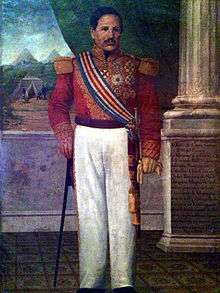Luis Batres Juarros
Luis Batres Juarros or Luis Batres y Juarros (New Guatemala de la Asunción 7 May 1802 – 17 June 1862) was an influential conservative Guatemalan politician during the regime of General Rafael Carrera. Member of the Aycinena clan, was in charge of writing most of the legislation that was enacted during this period.[1] The liberal historians portray him as a villain in a despotic and tyrannical government headed by illiterate Raca Carraca - Rafael Carrera - who was taking each and every one of Batres recommendations since he was considered infallible;[2] [3][4] However, research conducted between 1980 and 2010 has shown a more objective biography of both Batres and Rafael Carrera and show that it was in fact Carrera who had the reins of the Conservative government.[5] [6] [7]
Luis Batres Juarros | |
|---|---|
 | |
Guatemala City Mayor | |
| In office 1845–1846 | |
| President | Rafael Carrera |
Counsellor of State Republic of Guatemala | |
| In office 1847–1860 | |
| President | Rafael Carrera |
| Personal details | |
| Born | 7 May 1802 Nueva Guatemala de la Asunción |
| Died | 17 June 1862 (aged 60) |
| Political party | Conservative |
| Spouse(s) | Adelaida García Granados y Zavala[Note 1] |
| Children | María Gertrudis, Mercedes, Trinidad and Luis González de Batres y García Granados |
| Occupation | politician |
Biography

Batres Juarros was the son of José María González de Batres y Muñoz and María de las Mercedes Juarros Lacunza. He attended the Pontifical University of San Carlos Borromeo from which he graduated in 1823. He participated in the war against Francisco Morazán and his liberal forces under the command of the Governor of Guatemala, Mariano de Aycinena y Piñol with whom he was related. After Aycinena's defeat, he was banished by Morazan with another one hundred families belonging to the Aycinena clan, going into exile to Panama and then to the United States. He returned to Guatemala in 1839 when rebel general Rafael Carrera began to assert his authority in the state and managed to become one of his top aides and government ministers [8] He even got his wife, Adelaida García Granados, to become a confidant and mentor to Carrera's wife, Petrona Alvarez [9]
State of Los Altos
After the violent and bloody reinstatement of the State of Los Altos by Carrera in April 1840, Batres Juarros -then secretary general of the Guatemalan government of recently reinstated Mariano Rivera Paz- obtained from the vicar Larrazabal authorization to dismantle the regionalist Church. Acting priests of Quetzaltenango -capital of the would-be-state of Los Altos, priest Urban Ugarte and his coadjutor, priest José Maria Aguilar, were removed from their parish and likewise the priests of the parishes of San Martin Jilotepeque and San Lucas Tolimán. Larrazabal ordered the priests Fernando Antonio Dávila, Mariano Navarrete and Jose Ignacio Iturrioz to cover the parishes of Quetzaltenango, San Martin Jilotepeque and San Lucas Toliman, respectively.[10]
References
- Woodward 1993, p. 256.
- Montúfar & Salazar 1892.
- Rosa 1974.
- Hernández de León 1930.
- Woodward 1993.
- Woodward 2002.
- González Davison 2008.
- González Davison 2008, p. 6-154.
- González Davison 2008, p. 174.
- Taracena 1999, p. 240-241.
Bibliography
- Chandler, David L (1978). "The house of Aycinena". Revista de la Universidad de Costa Rica (in Spanish). San José, Costa Rica.CS1 maint: ref=harv (link)
- González Davison, Fernando (2008). La montaña infinita;Carrera, caudillo de Guatemala (in Spanish). Guatemala: Artemis y Edinter. ISBN 84-89452-81-4.CS1 maint: ref=harv (link)
- Hernández de León, Federico (1959). "El capítulo de las efemérides". Diario La Hora (in Spanish). Guatemala.CS1 maint: ref=harv (link)
- Hernández de León, Federico (1930). El libro de las efemérides (in Spanish). Tomo III. Guatemala: Tipografía Sánchez y de Guise.CS1 maint: ref=harv (link)
- López Vallecillos, Italo (1966). Gerardo Barrios y su tiempo (in Spanish). San Salvador, El Salvador: Dirección Nacional de Publicaciones del Ministerio de Educación.CS1 maint: ref=harv (link)
- Martínez Peláez, Severo (1988). Racismo y Análisis Histórico de la Definición del Indio Guatemalteco (in Spanish). Guatemala: Editorial Universitaria.CS1 maint: ref=harv (link)
- Martínez Peláez, Severo (1990). La patria del criollo; ensayo de interpretación de la realidad colonial guatemalteca (in Spanish). México: Ediciones en Marcha.CS1 maint: ref=harv (link)
- Milla y Vidaurre, José (1980). Cuadros de Costumbres. Textos Modernos (in Spanish). Guatemala: Escolar Piedra Santa.CS1 maint: ref=harv (link)
- Montúfar, Lorenzo; Salazar, Ramón A. (1892). El centenario del general Francisco Morazán (in Spanish). Guatemala: Tipografía Nacional.CS1 maint: ref=harv (link)
- Rosa, Ramón (1974). Historia del Benemérito Gral. Don Francisco Morazán, ex Presidente de la República de Centroamérica (in Spanish). Honduras: Ministerio de Educación Pública, Ediciones Técnicas.
- Stephens, John Lloyd; Catherwood, Frederick (1854). Incidents of travel in Central America, Chiapas, and Yucatan. London, England: Arthur Hall, Virtue and Co.CS1 maint: ref=harv (link)
- Taracena, Arturo (1999). Invención criolla, sueño ladino, pesadilla indigena, Los Altos de Guatemala: de región a Estado, 1740-1871 (in Spanish). Guatemala: CIRMA. Archived from the original on 2016-01-09. Retrieved 2015-01-09.CS1 maint: ref=harv (link)
- Weaver, Frederic S. (March 1999). "Reform and (Counter) Revolution in Post-Independence Guatemala: Liberalism, Conservatism, and Postmodern Controversies". Latin American Perspectives. 26 (2): 129–158.CS1 maint: ref=harv (link)
- Woodward, Ralph Lee Jr. (2002). "Rafael Carrera y la creación de la República de Guatemala, 1821–1871". Serie monográfica (in Spanish). CIRMA y Plumsock Mesoamerican Studies (12). ISBN 0-910443-19-X. Archived from the original on 2019-03-01. Retrieved 2015-01-09.CS1 maint: ref=harv (link)
- Woodward, Ralph Lee Jr. (1993). Rafael Carrera and the Emergence of the Republic of Guatemala, 1821-1871 (Online edition). Athens, Georgia EE.UU.: University of Georgia Press. Retrieved 28 December 2014.CS1 maint: ref=harv (link)
Notes
- Sister of both Miguel García Granados and María Josefa García Granados. Aunt of María García Granados y Saborío.